
MyISAM vs InnoDB: Discover well-informed MySQL Storage Engines
The storage engine that is used with MySQL databases can have a big impact on features, dependability, and performance for developers. MyISAM and InnoDB are two of the most used engines. This article explain difference between MyISAM vs InnoDB and advantages and disadvantages of each database engines.
MyISAM Overview
MyISAM, which was originally MySQL’s default storage engine, is renowned for being easy to use and quick while performing read-heavy activities. It works especially effectively in settings where data is mostly read rather than changed often.

InnoDB Overview
MySQL version 5.5, InnoDB is the default storage engine. It is perfect for transactional applications because it provides advanced functionality including row-level locking, foreign key constraints, and ACID-compliant transactions.

MyISAM vs InnoDB
Here are few points that showing MySQL Storage engines difference of MyISAM vs InnoDB
Storage MyISAM stores its tables, data and indexes in diskspace using separate three different files. (tablename.FRM, tablename.MYD, tablename.MYI), InnoDB stores its tables and indexes in a tablespace
Locking Mechanisms MyISAM implements table-level locking, while InnoDB offers row-level locking.
Transactions: InnoDB supports transactions, providing commit, rollback, and crash-recovery capabilities to protect user data. MyISAM lacks this feature
Foreign Key Support InnoDB enforces referential integrity by supporting foreign keys, unlike MyISAM does not support foreign keys
Performance: Given that MyISAM was created with speed in mind, it might operate more quickly in some read-intensive applications. However, this difference has closed thanks to InnoDB’s advancements, particularly in highly concurrent systems. InnoDB was created to operate at peak efficiency when handling large amounts of data.
Which option you choose between MyISAM and InnoDB will depend on your application’s particular needs. MyISAM may work well for processes that involve a lot of reading or for older systems. However, InnoDB is typically the recommended option for contemporary transactional systems.


